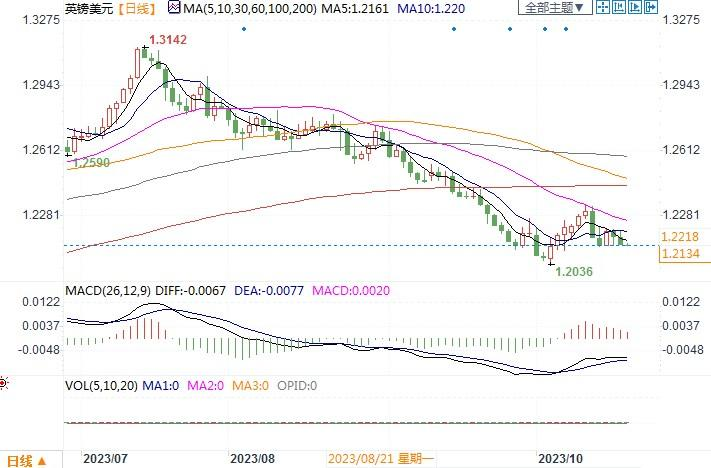Currency: Euro/USD
Resistance level 2:1.0640
Resistance level 1:1.0570
Spot price: 1.0533
Support bit 1:1.0490
Support bit 2: 1.0448
On Wednesday (October 18th), the US dollar continued to show strength as the benchmark 10-year US bond yield hit a 16 year high of 4.91%, further widening the gap between the yield of Eurozone bonds during the same period, causing the euro to fall 0.38% against the US dollar to 1.0536. On the news, on Wednesday, numerous officials from the Federal Reserve expressed their views on the issue of US dollar interest rates. Among them, Federal Reserve Governor Waller stated on Wednesday that he hopes to "wait, observe, and wait" whether the US economy will continue to maintain strong momentum or show signs of weakness after the Fed's interest rate hikes so far. This statement is a strong signal that the Federal Reserve will not raise interest rates at its next meeting, but it is likely to do so in the future. New York Federal Reserve Bank President Williams stated on Wednesday that interest rates need to remain high for a period of time in order to bring inflation back to the Fed's target of 2%. Federal Reserve Chairman Powell and several regional Fed presidents will also make comments on Thursday. If Federal Reserve officials remain steadfast in their stance on whether to raise or stop interest rates, the US dollar is expected to continue to receive support and remain strong. In terms of technical graphics, the daily chart shows almost no trend bias, while the weekly chart still shows a main trend leaning downwards, with signals pointing downwards. The two ends of the October trading range of 1.0448-1.0640 are preliminary support and resistance levels, respectively.
Currency: GBP/USD
Resistance level 2:1.2240
Resistance level 1:1.2200
Spot price: 1.2138
Support bit 1:1.2100
Support bit 2:1.2080
On Wednesday (October 18th), the pound fell 0.32% to 1.2144 against the US dollar in late trading. Consumer price inflation (CPI) in the UK unexpectedly remained at a level of 6.7% in September, still the highest among all major developed economies. Affected by this, the pound briefly rose, but later turned from up to down. Although the UK inflation rate is slightly higher than expected, there may not be anything in this inflation report that will prompt the Bank of England to raise interest rates again in November. According to forecasts from the International Monetary Fund (IMF) last week, the UK has the highest inflation rate among the developed economies of the Group of Seven (G7), but the economic growth rate is expected to be the slowest next year. On the other hand, on the same day, the yield of US Treasury bonds hit a historic high in the market, which continued to maintain the strong momentum of the US dollar. In terms of technical graphics, whether on hourly or daily charts, the exchange rate falls below the central trajectory of the Bollinger Belt, and the downward trend is still relatively obvious. Pay close attention to the support of 1.2100 below. If worn down, the support of 1.20 level will be tested again below. There is no strong resistance above that has broken through the recent oscillation zone of 1.23, and there may be hope of reversing the decline.
Currency: USD/JPY
Resistance level 2:151.00
Resistance level 1:150.29
Spot price: 149.75
Support bit 1:149.00
Support bit 2:148.35
On Wednesday (October 18th), the US dollar/yen reached a two-week high of 149.92, close to the warning level of 150. To investors' surprise, the Bank of Japan announced the purchase of $2 billion in bonds to maintain downward pressure on yields. Investors not only did not see the Bank of Japan intervene in the yen exchange rate, but also provided assistance to the rise of the US dollar. And the most fundamental thing is that US bond yields are even stronger, with the 10-year US bond yield at 4.939%, which is at a cyclical high. The widening Japanese US interest rate spread will ultimately continue to support the strong performance of the US dollar. However, due to the large number of protective options expiring in the past two trading days between 149 and 150, it may temporarily help to curb the further weakening of the yen to some extent. At present, the fluctuation of the US dollar/yen is extremely narrow, and it is not possible to break through the 150 warning level, but the downward trend is extremely limited. Investors are mainly observing the suitability of this currency in recent times.


